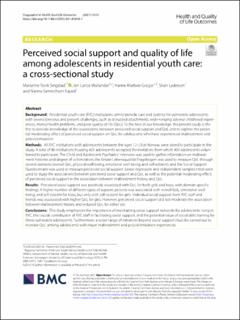| dc.contributor.author | Singstad, Marianne Tevik | |
| dc.contributor.author | Wallander, Jan Lance Anders | |
| dc.contributor.author | Greger, Hanne Klæboe | |
| dc.contributor.author | Lydersen, Stian | |
| dc.contributor.author | Kayed, Nanna Sønnichsen | |
| dc.date.accessioned | 2021-06-11T09:58:56Z | |
| dc.date.available | 2021-06-11T09:58:56Z | |
| dc.date.created | 2021-01-22T10:40:03Z | |
| dc.date.issued | 2021 | |
| dc.identifier.citation | Health and Quality of Life Outcomes. 2021, 19 (1), . | en_US |
| dc.identifier.issn | 1477-7525 | |
| dc.identifier.uri | https://hdl.handle.net/11250/2758947 | |
| dc.description.abstract | Background: Residential youth care (RYC) institutions aim to provide care and stability for vulnerable adolescents with several previous and present challenges, such as disrupted attachments, wide-ranging adverse childhood experiences, mental health problems, and poor quality of life (QoL). To the best of our knowledge, the present study is the frst to provide knowledge of the associations between perceived social support and QoL and to explore the potential moderating efect of perceived social support on QoL for adolescents who have experienced maltreatment and polyvictimization. Methods: All RYC institutions with adolescents between the ages 12–23 in Norway were asked to participate in the study. A total of 86 institutions housing 601 adolescents accepted the invitation, from which 400 adolescents volunteered to participate. The Child and Adolescent Psychiatric Interview was used to gather information on maltreatment histories and degree of victimization; the Kinder Lebensqualität Fragebogen was used to measure QoL through several domains (overall QoL, physical well-being, emotional well-being, and self-esteem); and the Social Support Questionnaire was used to measure perceived social support. Linear regression and independent samples t-test were used to study the associations between perceived social support and QoL as well as the potential moderating efect of perceived social support in the association between maltreatment history and QoL. Results: Perceived social support was positively associated with QoL for both girls and boys, with domain-specifc fndings. A higher number of diferent types of support persons was associated with overall QoL, emotional wellbeing, and self-esteem for boys, but only with self-esteem for girls. Individual social support from RYC staf and friends was associated with higher QoL for girls. However, perceived social support did not moderate the association between maltreatment history and reduced QoL for either sex. Conclusions: This study emphasizes the importance of maintaining social support networks for adolescents living in RYC, the crucial contribution of RYC staf in facilitating social support, and the potential value of social skills training for these vulnerable adolescents. Furthermore, a wider range of initiatives beyond social support must be carried out to increase QoL among adolescents with major maltreatment and polyvictimization experiences. | en_US |
| dc.language.iso | eng | en_US |
| dc.publisher | BioMed Central, Springer Nature | en_US |
| dc.rights | Navngivelse 4.0 Internasjonal | * |
| dc.rights.uri | http://creativecommons.org/licenses/by/4.0/deed.no | * |
| dc.title | Perceived social support and quality of life among adolescents in residential youth care: a cross-sectional study | en_US |
| dc.type | Peer reviewed | en_US |
| dc.type | Journal article | en_US |
| dc.description.version | publishedVersion | en_US |
| dc.source.pagenumber | 29 | en_US |
| dc.source.volume | 19 | en_US |
| dc.source.journal | Health and Quality of Life Outcomes | en_US |
| dc.source.issue | 1 | en_US |
| dc.identifier.doi | 10.1186/s12955-021-01676-1 | |
| dc.identifier.cristin | 1876992 | |
| dc.description.localcode | This article is licensed under a Creative Commons Attribution 4.0 International License, which permits use, sharing, adaptation, distribution and reproduction in any medium or format, as long as you give appropriate credit to the original author(s) and the source, provide a link to the Creative Commons licence, and indicate if changes were made. The images or other third party material in this article are included in the article's Creative Commons licence, unless indicated otherwise in a credit line to the material. If material is not included in the article's Creative Commons licence and your intended use is not permitted by statutory regulation or exceeds the permitted use, you will need to obtain permission directly from the copyright holder. To view a copy of this licence, visit http://creativecommons.org/licenses/by/4.0/. The Creative Commons Public Domain Dedication waiver (http://creativecommons.org/publicdomain/zero/1.0/) applies to the data made available in this article, unless otherwise stated in a credit line to the data. | en_US |
| cristin.ispublished | true | |
| cristin.fulltext | original | |
| cristin.qualitycode | 1 | |

